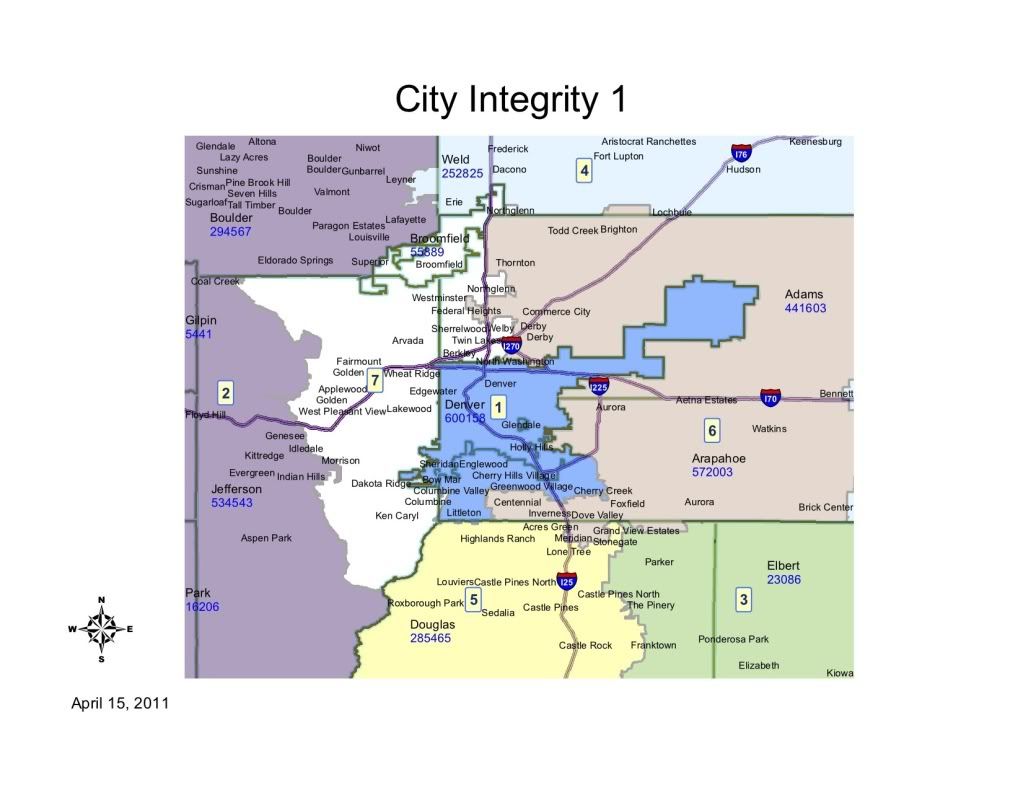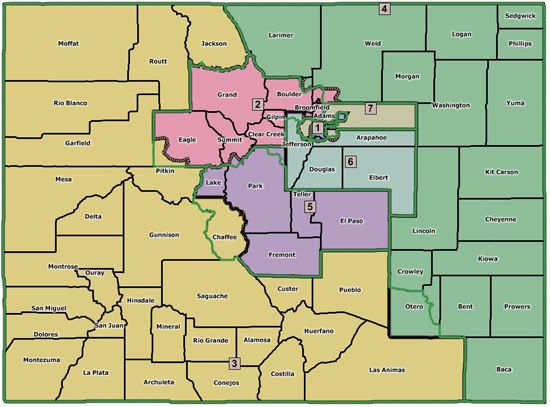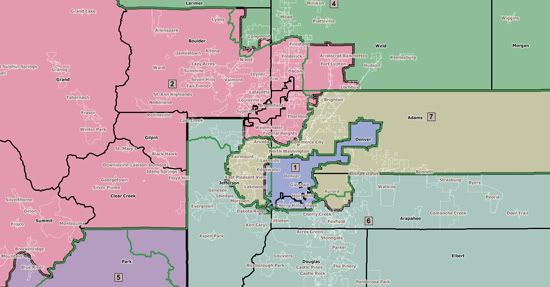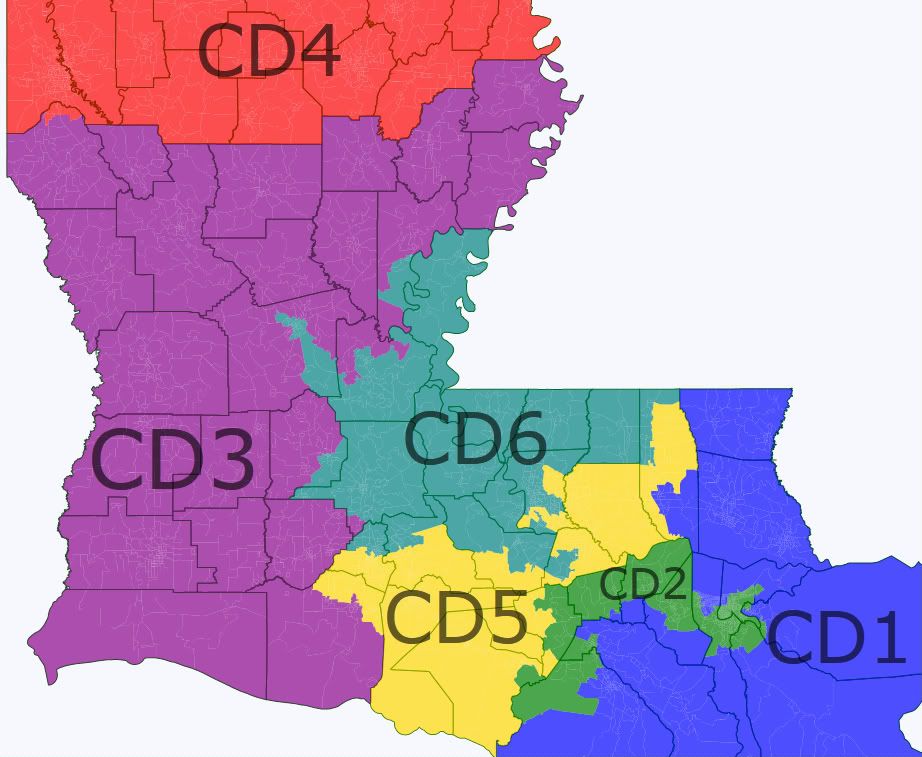So, on the one hand, I love fairness and justice and support the Voting Rights Act.
On the other hand, I hate stupid gerrymandering and the jiggering of districts to try to make them “safe.” For either party. (I mean, really, it’s fun to pretend to be Tom DeLay for a while . . . but only on Halloween.)
So I decided to use Dave’s Redistricting App to try my hand at redistricting Illinois. Fo’ realz. As in, I wanted to create a map that (a) could actually be adopted, (b) wouldn’t make an outsider gape in horror and (c) within those parameters, does all the things a good liberal would like it to do. Unlike other posters here, I’m not trying to optimize for Democratic interests — I’m trying to optimize for the interests of everyone in the state. A state that happens to contain a lot of Democrats.
One problem, though, is that I don’t know where to find the district-by-district voting data that would tell me which of my districts are solid Democratic, solid Republican or leaners. I can make educated guesses, but I don’t know for sure. This is one of the things I’m hoping you folks will help me with.

Methodology and more maps below the jump.
I began my mapmaking process without reference to existing districts. Outside Chicagoland, I formed districts around Census-recognized metropolitan and micropolitan statistical areas. For instance, in my map, IL-15 began as the Peoria MSA. As I saw where districts were forming, and knowing how many districts I ultimately had to create, I made the Springfield MSA part of IL-15 as well, then joined them by adding the counties in between. To my mind, metropolitan areas are “communities of interest,” and stunts like splitting Bloomington in half to dilute its vote burn my ass. (That being said, a large enough city may certainly contain more than one community of interest, but I’ll come to that later.)
Within Chicagoland, I started off with locally recognized super-communities: North Side, Northwest Side, West Side, etc. Because of the need to create majority-minority districts, I drew district lines along sharp ethnic boundaries (which in any case are inseparable from people’s notions of what neighborhoods belong to which “side”). None of these districts was large enough to be contained within the city, so I extended them outward into Cook County in ways that (I hoped) wouldn’t dilute their composition too much. Particularly in western Cook County, this took some jiggering.
As much as possible, I strove to keep these areas intact and my district boundaries in close conformity to county boundaries. Where I couldn’t go by counties, I tried to go by townships. I violated the convexity principle only where necessary to achieve population balance in a district, and I avoided “stringy” districts entirely. I can’t stand those things.
All districts deviate less than 1 percent from equal population share (712,813).
Enough talk. Maps!

Closeup on Chicagoland.

Central and southern Chicago.
IL-01 (South Side Chicago, Evergreen Park, Oak Lawn): 712,314, 62% black, 25% white, 10.3% Latino
IL-02 (Southwest Side Chicago, Burbank, Lemont): 712,295, 56.9% Latino, 31.4% white, 6% black
IL-03 (South Loop, West Side Chicago, Oak Park, La Grange, Burr Ridge, Argonne): 715,690, 41% white, 38.2% black, 14.1% Latino, 5.3% Asian
IL-01 was the easiest to draw. IL-02 was easy to draw in the city and inner suburbs, but became tricker the further out I had to go. Its shape comes in part from southward pressure from IL-03, which was a lot more difficult. The West Side has really emptied out in the last decade, and it was a challenge to include enough African American residents, even reaching out into the majority-black suburbs. I tried to make sure the district comprised the more progressive western suburbs.

Northern Chicago.
IL-04 (Northwest Side Chicago, Bensenville, Addison): 714,664, 49.6% white, 40.8% Latino, 5.4% Asian
IL-05 (North Side Chicago, North Shore): 715,394, 67.7% white, 10.8% Latino, 10.1% Asian, 9.3% black
I wish I could have stretched IL-04 all the way out to Elgin, but it wasn’t to be; any direction I try to expand it in just dilutes the Latino vote further. This seems to be as good as it gets. To compensate, it includes the Albany Park neighborhood, which is home to a large population of immigrants of various ethnicities, who presumably will share certain interests with the Latino community. IL-05 originally included Skokie and Lincolnwood, but then I decided to give those to IL-07 (to give the northwest suburban district more Democrats) and drown wealthy Wilmette, Kenilworth and Winnetka in a sea of lakefront liberals. Ha! (And you can’t say it’s not a community of interest, because if there’s one thing true North Shore residents agree on, it’s that if it’s inland, it’s not the North Shore! If cliquish identity protection doesn’t indicate a community of interest, what does?)

Northern Chicagoland.
IL-07 (Skokie, Northwest Cook): 716,103, 74.2% white, 13.2% Asian, 9.5% Latino
IL-08 (Lake): 710,303, 69.3% white, 16.8% Latino, 6.3% black, 6.2% Asian
IL-09 (McHenry, Elgin, Schaumburg): 710,672, 71.4% white, 16.8% Latino, 7.9% Asian
The northwest suburbs are clearly a community of interest and belong together, though I tried to give the sprawliest parts of Outer Sprawlville to IL-09. Lake County was so close to the necessary population size all by itself that it made sense to make it a single district, with just enough of McHenry County to finish the job.

DuPage County.
IL-10 (DuPage, Geneva-St. Charles): 713,223, 76.3% white, 9.9% Latino, 9.1% Asian
This district’s backbone is the Metra Union Pacific West Line (there’s a bright-line distinction in my mind between streetcar suburbia and sprawl suburbia). Naperville had to be cut out because otherwise the population would just be too darn big, and because I think Napervillians need to be cognizant of the fact that there wouldn’t be a Naperville without Aurora.

Western and Southern Chicagoland.
IL-06 (South Cook, University Park): 712,794, 52.2% black, 36.5% white, 8.9% Latino
IL-11 (Kane, Naperville, Bolingbrook, Oswego): 713,266, 66.5% white, 18% Latino, 7.3% Asian, 7.2% black
IL-12 (Will, Kankakee): 715,230, 77.6% white, 11.3% Latino, 8.2% black
Unfortunately, Orland Hills and Tinley Park are just too populous and too white to include them in IL-06, which is why I violate county borders here to exclude them and include University Park. IL-11 and IL-12 practically drew themselves once the other Chicagoland districts were in place — except for Grundy County, where IL-12 meets IL-14 and even stepping down to township boundaries made it hard to find the right balance. My apologies to Morris. Aurora and Naperville will have to find some way to live together in peace and harmony.

Northwest Illinois.
IL-13 (Rockford, DeKalb, Northwest Illinois): 710,857, 82.7% white, 8.3% Latino, 6.4% black
This is the district I reside in at the moment, and it gives me pleasure to take the McHenry County exurbs away from Don Manzullo. Tool.

Central Illinois.
IL-14 (Quad Cities, Ottawa/La Salle, Western Illinois): 713,441, 89.5% white
IL-15 (Peoria, Springfield, Central Illinois): 707,857, 87.9% white, 7.6% black
IL-16 (Champaign, Bloomington, Decatur, Eastern Illinois): 708,620, 82.8% white, 8.4% black
Eggheads unite! No more shall Champaign and Bloomington be kept apart! (And no more shall one side of Bloomington be kept apart from the other!) Peoria and Springfield grew together organically, and IL-14, which seemed to be too underpopulated no matter what I tried, just sort of seeped into what was left between the other districts I drew, which is how it ended up including so much of the I-80 corridor.

Southern Illinois.
IL-17 (St. Louis MSA): 711,447, 82.1% white, 13.6% black
IL-18 (Southern Illinois): 716,642, 91.6% white, 5% black
I do have some concern about whether East St. Louis will be outshouted by exurban Tea Partiers, but without any voting data to go by, I have no basis for splitting up the Illinois portion of the St. Louis MSA. The highest-numbered district, in my scheme as in the current one, gets everything that’s left.
OK, so . . . does my districting scheme fail to maximize Democratic votes? Absolutely, yes, if maximizing Democratic votes means doing what silver spring did. But I’m not looking to maximize Democratic votes per se, but rather to let that voice come out where it’s naturally strong. If I have any concern on this score, it’s whether the lines I’ve drawn have accidentally amplified the Republican voice. That I wouldn’t want to do. My goal is a map that’s fair to everyone, yet reflects the reality of a majority-Democratic state.
So here’s what I’m asking for:
– Analysis of the likely partisan leanings of each of my districts, since I don’t have the voter data and don’t know where to get it, but obviously many of you do. (Envy! Envy!)
– Observations of where I’ve accidentally undermined my own goals (for instance, if I’ve actually violated the VRA somewhere).
– Suggestions of how I might improve my map without turning it ugly (and I think you know what I mean by “ugly”). My ultimate goal is a map that can be submitted to the state redistricting committee as the serious product of a concerned and involved citizen. Which I’m pretty sure will fall on deaf ears, but I still intend to try.
– Whether there’s any sufficiently large (let’s say, > 70,000 residents) community of interest somewhere that’s so much at odds with the rest of its surroundings that it needs to be part of a different district, and whether there’s any appropriate district near enough to which it could feasibly be joined.





















